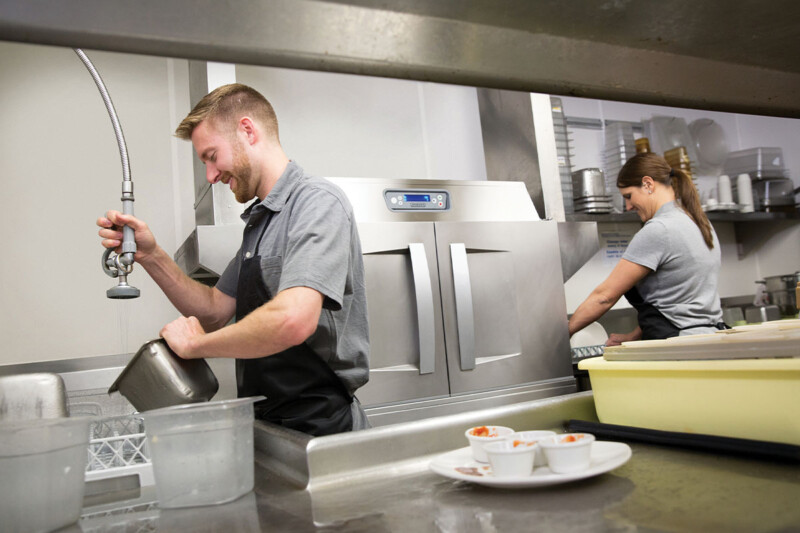Best Practices: Disposer Care
When it comes to getting rid of food waste, you have several options depending on your municipality: tossing scraps in the garbage to haul to the landfill, diverting scraps to a pulper or grinder—and perhaps on to a subsequent treatment method such as a digester or dehydrator—or grinding food scraps through a disposer and down the drain. A disposer is a direct disposal method and likely the least aromatic of the food waste options available.
We asked several service technicians and disposer manufacturers for their best practices when it comes to keeping the disposer working regularly for years and here’s what they shared.
General Operation Tips
Never run your disposer dry. Always start by running water first, turning on the disposer and then begin to push scraps into the unit opening. If your employees fill the grind chamber full of food waste, turn on the water and then turn on the disposer (or worse, fill the disposer, hit the on switch and then run the water), they can jam the unit and clog drain lines.
When running water, cold water is best as it will coagulate greasy residue and keep produce scraps crisper and easier to grind. Hot water is not recommended and it can be hard on seals.
Disposers are for food waste only. Do not let your employees shove cups, straws, cartons, napkins, utensils (metal or plastic), plastic wrap, gloves or glass of any sort down the disposer. And watch out for the rubber bands and metal twist ties found around bunches of produce—they are bad for disposers. Set up the scrapping area so they have a ready place to toss non-disposer trash.
Certain foods are just tough on these units. Stringy, fibrous fruits and vegetables, such as celery stalks, onion skins, pineapple tops, artichokes and corn husks, can get balled up in the grinding mechanisms, clog up the drain and compromise the seals. Oyster shells are rough going, too. You can put these items in, but instruct employees to go easy on the load, feeding just a little at a time; better yet, just toss these types of items to the garbage.
Thick, starchy items—think pasta, casseroles, sweet potatoes (skins and all)—should be added in at a rate that lets the disposer process without jamming. In fact, too-large a load of any item shoved in too quickly is called batch-loading, and it’s asking for trouble. Smaller loads fed at a steady pace will grind the waste and send it down the drain. Done properly, you can put just about any food into the disposer, from corn cobs to thick steak bones.
Do not run harsh chemicals down the garbage disposer. Chemicals can pit and corrode the grinding mechanisms and seals causing premature failures.
To clean out the disposer, and push waste down the drain, always run the water an additional 20 seconds after the grind load is through. Adding a cup of ice (or frozen cubes of vinegar) down the disposer will help clean out the residue, as well. You also can put lemon or orange wedges in to deodorize the disposer and the oils will help freshen the interior.
One final note on cleaning: do not let your staff or the after-hours cleaning crew aim a hose at the disposer or its control box. Water can damage the unit’s electronics. Put up a Do Not Spray sign if you need to.
Planned Maintenance
Before performing any maintenance or parts replacement on a disposer, shut off the main power.
Check that the vinyl, silver-trap scraping ring, also known as a baffle, is fully seated and in good shape—it’s that pliable vinyl ring at the mouth of the disposer.
Under the disposer, check for leaks, water flow, excessive noise or vibration. If you see water leaking from the disposer, stop using it and call a service company; water leaks can damage the motor and circuits. If you instruct employees to wipe down the exterior of the disposer before a shift begins each week—when the whole scrapping area is dry—they’ll be more likely to spot a leak.
Look for cuts and holes in the connector sleeve that attaches the unit to the sink; it could need replacing. Check for tight connections, especially the drain coupling that connects the disposer to the drain.
The disposer should be securely connected to the sink, and if it comes with legs (larger versions), level on the floor to mitigate too much vibration.
Make sure the rotor in the grind chamber rotates easily; most manufacturers offer a dejamming wrench that you can use to loosen the rotor after a jam. Again, make sure the unit is off when you’re about to use the dejamming wrench.
In commercial disposers, a center flywheel rotates two metal pieces called impact bars. They’re responsible for centrifugally forcing food waste into the grinding ring around the perimeter of the grind chamber. You can really extend the life of your disposer if you reverse the impact bars when they’re starting to wear. Some brands offer controls that allow you to run the shredder plate in reverse. On others, the impact bars can be manually reversed.
If your disposer trips the overload more than once (typically, it’s a red button on the bottom of the unit), call a service company. Something’s up and it’s better to see it professionally serviced before you ruin the disposer and/or the overload mechanism.
RELATED CONTENT
- Advertisement -
- Advertisement -
- Advertisement -
TRENDING NOW
- Advertisement -
- Advertisement -
- Advertisement -


